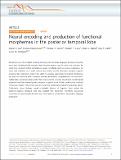Neural encoding and production of functional morphemes in the posterior temporal lobe
Author(s)
Lee, Daniel K; Fedorenko, Evelina; Simon, Mirela V; Curry, William T; Nahed, Brian V; Cahill, Dan P; Williams, Ziv M; ... Show more Show less
DownloadPublished version (2.488Mb)
Publisher with Creative Commons License
Publisher with Creative Commons License
Creative Commons Attribution
Terms of use
Metadata
Show full item recordAbstract
© 2018 The Author(s). Morphemes are the smallest meaning-carrying units in human language, and are among the most basic building blocks through which humans express specific ideas and concepts. By using time-resolved cortical stimulations, neural recordings, and focal lesion evaluations, we show that inhibition of a small cortical area within the left dominant posterior-superior temporal lobe selectively impairs the ability to produce appropriate functional morphemes but does not distinctly affect semantic and lexical retrieval, comprehension, or articulation. Additionally, neural recordings within this area reveal the localized encoding of morphological properties and their planned production prior to speech onset. Finally, small lesions localized to the gray matter in this area result in a selective functional morpheme-production deficit. Collectively, these findings reveal a detailed division of linguistic labor within the posterior-superior temporal lobe and suggest that functional morpheme processing constitutes an operationally discrete step in the series of computations essential to language production.
Date issued
2018Department
McGovern Institute for Brain Research at MIT; Harvard University--MIT Division of Health Sciences and TechnologyJournal
Nature Communications
Publisher
Springer Science and Business Media LLC